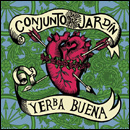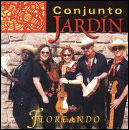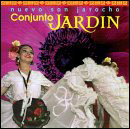| |
Conjunto
Jardin Recordings: |
|

Conjunto
Jardín
Yerba Buena
(2008)
Son jarocho describes
the vital and energetic Mexican folk music from the state
of Veracruz on the Gulf of Mexico. The third album from
the Harding sisters and their band Conjunto Jardín – the
name is a play on the Spanish pronunciation of Libby
and Cindy’s last name – continues the
driving rhythms, sparkling harp-and-requinto interplay
and trademark sibling vocals that characterized the
group’s first two efforts. But this time, many
more influences are brought into the mix, resulting
in new sounds, textures and arrangements.
A scant
few years ago the sacrilege of combining the quena
(reed flute) and zampoñas (bamboo
panpipes) – Andean instruments! – with
son jarocho would have been unthinkable. But Cindy
particularly is an accomplished Andean musician,
and sometimes the jarocho world cries out for more
tone colors.
And an accordion-driven version of the
traditional son jarocho “El Ahualulco” in
Colombian vallenato style? Hitherto unconsidered.
Yet, after encountering groups in Tlacotalpan, Veracruz
in 2001 incorporating harmonica into son jarocho,
keyboardist/accordionist Gary Johnson saw that it
was not exactly a leap to its cousin, the squeezebox.
The
traditional “Fandanguito” gets a
taut, emotion-charged treatment before transforming
into an Afro-Cuban setting of Libby’s “Para
Mis Muertos,” a poignant yet danceable montuno honoring
those who are gone but not forgotten.
Conjunto Jardín’s Latin Americanized
version of Procol Harum’s “Conquistador” is
already a big hit with the members of Procol and
their friends and families, having appeared on a
2004 tribute album issued by the band’s website. |
|
|
Multi-instrumentalist,
singer and instrument maker Jorge Mijangos and bassist
Rick Moors make their usual sterling contributions,
while the percussion duties are split between Marcel
Adjibi (El Capitán), who during the recording
of this album moved to Texas, veteran Peruvian cajonero
Gino Gamboa (El Obispo), and old friend Ricardo “Tiki” Pasillas
of Marc Anthony and Jennifer Lopez’ band.
Being based
in the U.S., Conjunto Jardín is perhaps constrained
by fewer rules than their counterparts in Mexico. And
just as on 2003’s Floreando they were
not afraid to join the lively sparkle of the Veracruz
port style with the more roots-oriented approach of
the movimiento jaranero, this third collection shows
no fear and recognizes no sacred cows.
Libby says: “When we were in Tlacotalpan in 2001, several viejitos [older
musicians] came up to us after we played and complimented us on our ‘inovaciones’ [innovations].
That made a big impression. We hope we can continue to carry forward this wonderful
tradition and even extend it, hopefully into new areas that stimulate the growth
and diffusion of the music as a whole.”
_______________
At the mixing controls once
again was Larry Hirsch, known for his work
with Los Lobos, Ry Cooder, Bonnie Raitt and many others.
Peruvian composer/producer Ciro Hurtado (Huayucaltía)
engineered the recording, while also contributing on guitar
to the “Latin Americanized” arrangement of Procol
Harum’s 1971 hit “Conquistador.”
Conjunto Jardín’s first release, Nuevo Son Jarocho (1998),
got excellent notices and radio play; its track “La Bruja” was featured
onPutumayo World Music’s 2001 compilation Music of
Mexico. The group’s second release, Floreando (2003), received
even more acclaim and lodged in the top 10 of the CMJ World Music airplay
chart for several weeks in 2003.
Conjunto Jardín was nominated for Best Latin/Salsa Artist in the 2003 L.A.
Weekly Music Awards, and is the recipient of an L.A. Treasures
Award from the City of Los Angeles Department of Cultural Affairs. |
|
 |

Floreando (2003, Trova Recordings) is
the second CD release from Conjunto Jardín.
Inspired by the group’s 2001 trip to Tlacotalpan,
Veracruz, Mexico, to participate in the annual son
jarocho extravaganza Encuentro de Jaraneros, the new
CD combines the rhythmic drive and virtuosic sparkle
associated with the port city of Veracruz with the
more rural, roots-oriented and percussion-flavored
style typical of Mono Blanco, Son de Madera and Los
Cojolites, Veracruz groups prominent in the current
resurgence of jarocho music.
From the first notes of the opening track –
“El Colás,” a typically irreverent
jarocho classic about a flirty guy – there’s
a definite groove going on that’s a little different
from what one might expect. The upbeat, driving “El
Torito” (The Little Bull) will satisfy fans of
the previous album, Nuevo Son Jarocho, and
its medley-mate “El Toro Zacamandú”
(The Magic Bull) percolates with energy. But the CD’s
real surprise is in the slower tracks – the restrained,
hypnotic chant of “El Coco”
and, especially, “La Guanábana,”
with its deliberate build-up and release that echos
the song’s lyrics of yearning sexuality.
At the mixing controls once again was Larry
Hirsch, known for his work with Los Lobos,
Ry Cooder, Bonnie Raitt and many others. Peruvian composer/producer
Ciro Hurtado (Huayucaltía) engineered the recording,
while also contributing an evocative guitar solo on
the Afro-Peruvian-influenced
“La Guanábana.” See reviews for Floreando here. |
|
|
-
click on images above to enlarge - |
Pronunciation
Guide
Conjunto Jardín: cone-HOON-toe
har-DEEN cone-HOON-toe
har-DEEN
Floreando: flor-eh-AHN-doe flor-eh-AHN-doe
son jarocho: sohn
ha-ROE-cho sohn
ha-ROE-cho
son: sohn sohn
Instruments
jarana: ha-RAH-nah ha-RAH-nah
requinto: reh-KEEN-toe reh-KEEN-toe
cajón: ka-HONE ka-HONE
quijada: kee-HAH-tha kee-HAH-tha
pandero: pan-DEH-roe pan-DEH-roe
leona: lay-OH-nah lay-OH-nah
Song titles
El Colás: el
ko-LAHSS el
ko-LAHSS
El Torito: el
tor-EE-toe el
tor-EE-toe
El Toro Zacamandú: el toro sac-a-man-DOO
El Coco: el
CO-co el
CO-co
La Rama: la
RAH-ma la
RAH-ma
La Guanábana: la
wa-NAH-ba-na la
wa-NAH-ba-na
El Gavilancito: el
gahv-ee-lahn-SEE-toe el
gahv-ee-lahn-SEE-toe
La Indita: la
een-DEE-ta la
een-DEE-ta
El Pijúl: el
pee-HOOL el
pee-HOOL
El Aguacero: el
ah-gwa-SEHR-oh el
ah-gwa-SEHR-oh
De Puerto en Puerto:
       deh
POOAIR-toe en POOAIR-toe deh
POOAIR-toe en POOAIR-toe
Floreando: flor-eh-AHN-doe flor-eh-AHN-doe |
|
| |
 |
“In
their new recording, Conjunto Jardin revitalizes the
joyful and polyrhythmic music of Veracruz, Mexico known
as son jarocho. Their unique rendition of classic
songs connects the more accessible styles of son
with the roots of this traditional genre.”
– Betto Arcos, former music director,
KPFK, Los Angeles |
Conjunto
Jardin: “La Rama” (“Floreando,”
Trova)
“Everything folks on this list have said praising
this group is true and then some; they’re one
of the most exciting and delightful revival bands I’ve
heard in years. Whether or not you think you like Mexican
music, you really, really should hear this recording.”
– Paul Stamler, KDHX, St. Louis,
MO |
“Talk about a flowering garden?
This is a beautiful recording, which I just received
for airplay on “Roots and Wings,” my weekly
folk music program in the Pocono Mtns of NE Pennsylvania.
There is a light-hearted Christmas song, “La Rama,”
which might be described as a Mexican wassail with improv
(ideal for the holiday season), and a fascinating glimpse
of the Afro-Mexican ties between Veracruz, on the Gulf
of Mexico, and West Africa, from which many slaves were
transported, “De Puerto en Puerto,” as another
of the songs sings in a defiantly happy tribute to the
human spirit (the very informative notes point to the
African roots of such songs as “El Torito/El Toro
Zacamandu” [The Little Bull/The Magic Bull]).
Another song, a sea-shanty, “El Coco,” about
a sea-bird, borrowed from marineros plying their trade
between Cuba and Veracruz - sung in Benin by African-born
percussionist Marcel Adjibi - underscores this centuries-old
link between the Old World and the New, specifically
in the Mexican gulf coast state of Veracruz and its
main port.
Conjunto Jardin is the flowering of the work of Prof.
Tim Harding, who made field recordings of Mexican regional
music in the early 1950s, for Moses Asch’s Folkways
Records, and has since gone on, not only to recall his
Mexican students at Cal State LA (in the middle of East
LA) to their Chicano roots, but also to encourage his
daughters, Libby and Cindy, to carry on this work. The
sound is brilliant but melodic, and the syncopated rhythms
lend a jazzy feel to the selection of "son jarocho"
(the music of Veracruz) represented here by a younger
generation of multicultural musicians, not only the
Harding sisters (vocals, various guitars, flute), and
Marcel Adjibi (congas, talking drums, vocals), but also
Mexican-born multi-instrumentalist Jorge Mijangos and
Rick Moors (El Tiburon [The Shark]) on bass. This is
a rich and lovely addition to your record library, and
worth more than a few spins on any folk music program
venturing beyond the Anglo tradition.
Thank you, Conjunto Jardin, and thank you, Prof. Harding.”
– John McLaughlin |
|

Conjunto Jardín’s
first release, Nuevo Son Jarocho (1998), got
excellent notices and radio play; its track “La
Bruja” was featured on Putumayo World Music’s
2001 compilation Music of Mexico.
For praise
for Nuevo Son Jarocho, see Press. |
|
|